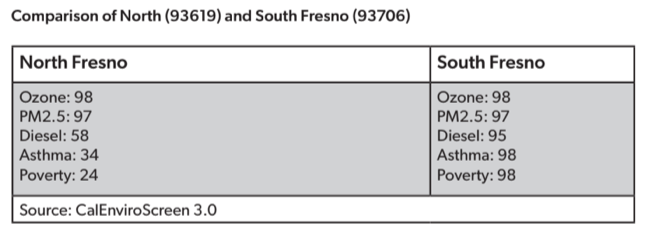
By Nayamin Martinez
It is well documented that the built environment is a key element of the social determinants of health. Where you live determines in great part your access to multiple basic services, clinics, schools and grocery stores. It determines the levels of pollution in the air that you breathe, your access to well-maintained public infrastructure (e.g., parks, roads, street lights) and even to green spaces.
For years, we have heard about the “tale of two cities,” which alludes to the historical disparities that exist between north and south Fresno. The life expectancy of residents in south Fresno is significantly lower than those living in the northern part of town. According to a study published in 2018 by the National Center for Health Statistics and the National Association for Public Health Statistics, the life expectancy of residents in south and central Fresno was 77 years, compared to 85 years for residents in northern Fresno.
Data from CalEnviroScreen 3.0 offer other examples of the disparities between the two Fresnos. CalEnviroScreen is a map and index created by the California Office of Environmental Health Hazard Assessment (OEHHA) that ranks communities according to their burden of pollution from multiple sources and their social vulnerability.
Communities with the worst pollution burden and highest social vulnerability ranked in the 90–100 percentile. The table below shows the differences between north and south Fresno for selected indicators; the addresses of Edison High (in south Fresno) and Clovis North (in North Fresno) high schools were used to create this table.

Source: CalEnviroScreen 3.0
While the pollution burden for ozone and PM2.5 is similar in the two parts of the city, there is a significant difference in the exposure to diesel and, not surprisingly, higher asthma rates in south Fresno.
Why is that? Among other things is the result of the land-use practices that the City of Fresno has followed: permitting mansions and shopping centers in the north and warehouses and distribution centers in the south.
Are you looking for an Ulta store? Head to Clovis or River Park, whereas a distribution center was installed two years ago next to the Amazon warehouse at Central Avenue in south Fresno.
These dire differences between the north and the south can be interpreted as examples of environmental racism because low-income people of color represent most of the residents in south Fresno (see the graph below).
Race and Ethnicity in 93706

Source: CalEnviroScreen 3.0
A recently published study provided further information on another type of inequity that prevails in the city of Fresno. According to the Tree Equity Score that the organization American Forests unveiled in June 2021, “trees are scarce in socioeconomically disadvantaged neighborhoods and more prominent in wealthier, whiter neighborhoods. Redlining policies laid the groundwork for this inequity.”
This is true for Fresno as well. The Tree Equity Score in the Clovis North area is 99 compared to 39 in the Edison High area. The closest to 100 means a neighborhood has more trees; a score of 100 represents tree equity. Again, the north fares better than the south.
Fortunately, there is hope on the horizon, at least to reverse the tree inequity through various initiatives. Recently, the Fresno electorate approved Measure P, a sales tax that will raise funds to expand access to green spaces and to arts and cultural programs. A portion of the funds will be used to plant more trees in current parks, and trails and new parks will be created in underserved neighborhoods.
Funds have also been allocated by the Air District to support urban greening projects and the installation of vegetative barriers between sensitive receptors (e.g., schools, homes) and sources of pollution (e.g., industry, freeways). All this is part of the AB 617 program that has been working since 2018 to improve air quality in south-central Fresno and portions of the neighboring unincorporated communities of Malaga and Calwa.
The inequities between north and south Fresno are the result of a long history of redlining and environmental racist practices that will not be undone in a few years. We need to begin by acknowledging these practices.
We need to work on comprehensive and systemic solutions that have the equity lens at the center and not isolated programs or initiatives that address just a few of these inequities. Having more trees in disadvantaged neighborhoods is a good start, but not enough.
*****
Nayamin Martinez is the executive director of the Central California Environmental Justice Network.

This article sucks because I have to read it for school other than that I like how you are highlighting the problems in Fresno even though nothing has changed